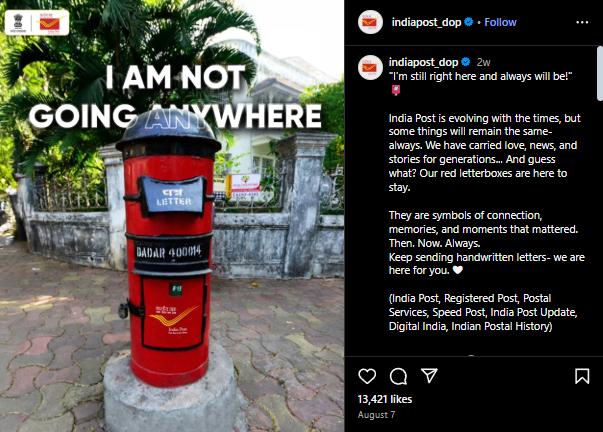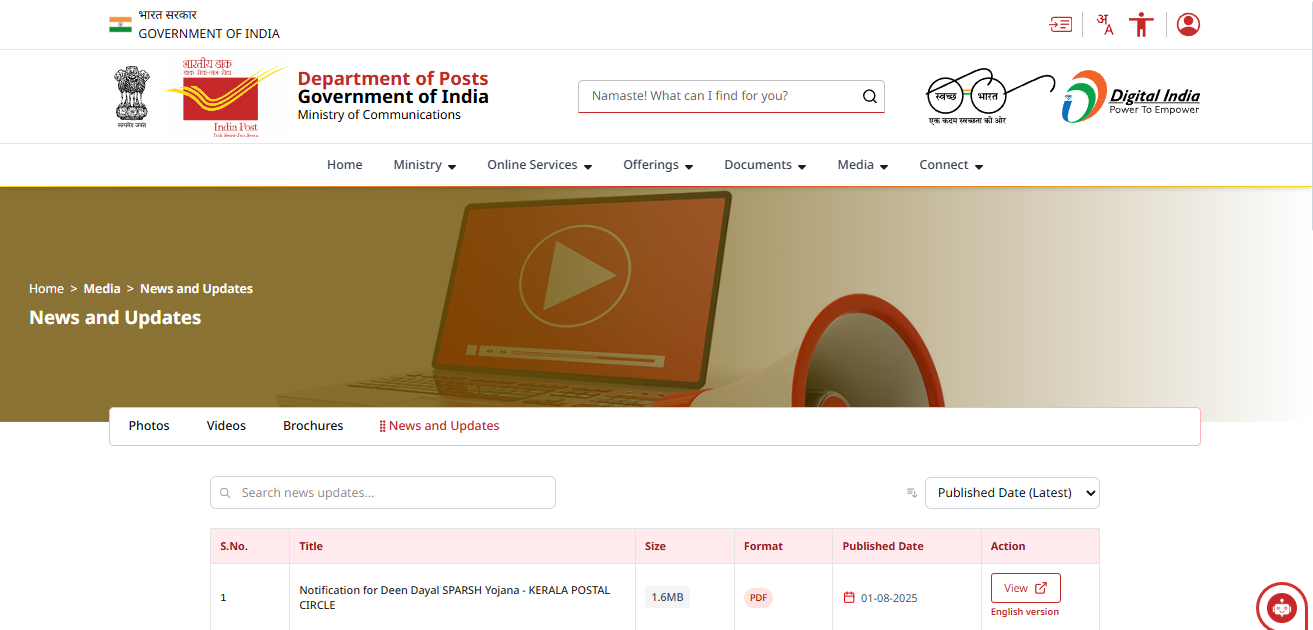#FactCheck: A viral claim suggests that India Post will remove all red letter boxes across the country beginning 1 September 2025.
Executive Summary:
A viral social media claim suggested that India Post would discontinue all red post boxes across the country from 1 September 2025, attributing the move to the government’s Digital India initiative. However, fact-checking revealed this claim to be false. India Post’s official X (formerly Twitter) and Instagram handles clarified on 7 August 2025 that red letterboxes remain operational, calling them timeless symbols of connection and memories. No official notice or notification regarding their discontinuation exists on the Department of Posts’ website. This indicates the viral posts were misleading and aimed at creating confusion among the public.
Claim:
A claim is circulating on social media stating that India Post will discontinue all red post boxes across the country effective 1 September 2025. According to the viral posts,[archived link] the move is being linked to the government’s push towards Digital India, suggesting that traditional post boxes have lost their relevance in the digital era.

Fact Check:
After conducting a reverse image analysis, we found that the official X handle of India Post, in a post dated 7 August 2025, clarified that the viral claim was incorrect and misleading. The post was shared with the caption:
I’m still right here and always will be!"
India Post is evolving with the times, but some things will remain the same- always. We have carried love, news, and stories for generations... And guess what? Our red letterboxes are here to stay.
They are symbols of connection, memories, and moments that mattered. Then. Now. Always.
Keep sending handwritten letters- we are here for you.
This directly refutes the viral claim about the discontinuation of the red post box from 1 September 2025. A similar clarification was also posted on the official Instagram handle @indiapost_dop on the same date.


Furthermore, after thoroughly reviewing the official website of the Department of Posts, Government of India, we found absolutely no trace, notice, or even the slightest mention of any plan to discontinue the iconic red post boxes. This complete absence of official communication strongly reinforces the fact that the viral claim is nothing more than a baseless and misleading rumour.

Conclusion:
The claim about the discontinuation of red post boxes from 1 September 2025 is false and misleading. India Post has officially confirmed that the iconic red letterboxes will continue to function as before and remain an integral part of India’s postal services.
- Claim: A viral claim suggests that India Post will remove all red letter boxes across the country beginning 1 September 2025.
- Claimed On: Social Media
- Fact Check: False and Misleading
Related Blogs

The Rise of Tech Use Amongst Children
Technology today has become an invaluable resource for children, as a means to research issues, be informed about events, gather data, and share views and experiences with others. Technology is no longer limited to certain age groups or professions: children today are using it for learning & entertainment, engaging with their friends, online games and much more. With increased digital access, children are also exposed to online mis/disinformation and other forms of cyber crimes, far more than their parents, caregivers, and educators were in their childhood or are, even in the present. Children are particularly vulnerable to mis/disinformation due to their still-evolving maturity and cognitive capacities. The innocence of the youth is a major cause for concern when it comes to digital access because children simply do not possess the discernment and caution required to be able to navigate the Internet safely. They are active users of online resources and their presence on social media is an important factor of social, political and civic engagement but young people and children often lack the cognitive and emotional capacity needed to distinguish between reliable and unreliable information. As a result, they can be targets of mis/disinformation. ‘A UNICEF survey in 10 countries’[1] reveals that up to three-quarters of children reported feeling unable to judge the veracity of the information they encounter online.
Social media has become a crucial part of children's lives, with them spending a significant time on digital platforms such as Youtube, Facebook, Instagram and more. All these platforms act as source of news, educational content, entertainment, peer communication and more. These platforms host a variety of different kinds of content across a diverse range of subject matters, and each platform’s content and privacy policies are different. Despite age restrictions under the Children's Online Privacy Protection Act (COPPA), and other applicable laws, it is easy for children to falsify their birth date or use their parent's accounts to access content which might not be age-appropriate.
The Impact of Misinformation on Children
In virtual settings, inaccurate information can come in the form of text, images, or videos shared through traditional and social media channels. In this age, online misinformation is a significant cause for concern, especially with children, because it can cause anxiety, damage self-esteem, shape beliefs, and skewing their worldview/viewpoints. It can distort children's understanding of reality, hinder their critical thinking skills, and cause confusion and cognitive dissonance. The growing infodemic can even cause an overdose of information. Misinformation can also influence children's social interactions, leading to misunderstandings, conflicts, and mistrust among peers. Children from low literacy backgrounds are more susceptible to fabricated content. Mis/disinformation can exacerbate social divisions amongst peers and lead to unwanted behavioural patterns. Sometimes even children themselves can unwittingly spread/share misinformation. Therefore, it is important to educate & empower children to build cognitive defenses against online misinformation risks, promote media literacy skills, and equip them with the necessary tools to critically evaluate online information.
CyberPeace Policy Wing Recommendations
- Role of Parents & Educators to Build Cognitive Defenses
One way parents shape their children's values, beliefs and actions is through modelling. Children observe how their parents use technology, handle challenging situations, and make decisions. For example, parents who demonstrate honesty, encourage healthy use of social media and show kindness and empathy are more likely to raise children who hold these qualities in high regard. Hence parents/educators play an important role in shaping the minds of their young charges and their behaviours, whether in offline or online settings. It is important for parents/educators to realise that they must pay close attention to how online content consumption is impacting the cognitive skills of their child. Parents/educators should educate children about authentic sources of information. This involves instructing children on the importance of using reliable, credible sources to utilise while researching on any topic of study or otherwise, and using verification mechanisms to test suspected information., This may sound like a challenging ideal to meet, but the earlier we teach children about Prebunking and Debunking strategies and the ability to differentiate between fact and misleading information, the sooner we can help them build cognitive defenses so that they may use the Internet safely. Hence it becomes paramount important for parents/educators to require children to question the validity of information, verify sources, and critically analyze content. Developing these skills is essential for navigating the digital world effectively and making informed decisions.
- The Role of Tech & Social Media Companies to Fortify their Steps in Countering Misinformation
Is worth noting that all major tech/social media companies have privacy policies in place to discourage any spread of harmful content or misinformation. Social media platforms have already initiated efforts to counter misinformation by introducing new features such as adding context to content, labelling content, AI watermarks and collaboration with civil society organisations to counter the widespread online misinformation. In light of this, social media platforms must prioritise both the designing and the practical implementation aspects of policy development and deployment to counter misinformation strictly. These strategies can be further improved upon through government support and regulatory controls. It is recommended that social media platforms must further increase their efforts to counter increasing spread of online mis/disinformation and apply advanced techniques to counter misinformation including filtering, automated removal, detection and prevention, watermarking, increasing reporting mechanisms, providing context to suspected content, and promoting authenticated/reliable sources of information.
Social media platforms should consider developing children-specific help centres that host educational content in attractive, easy-to-understand formats so that children can learn about misinformation risks and tactics, how to spot red flags and how to increase their information literacy and protect themselves and their peers. Age-appropriate, attractive and simple content can go a long way towards fortifying young minds and making them aware and alert without creating fear.
- Laws and Regulations
It is important that the government and the social media platforms work in sync to counteract misinformation. The government must consult with the concerned platforms and enact rules and regulations which strengthen the platform’s age verification mechanisms at the sign up/ account creation stage whilst also respecting user privacy. Content moderation, removal of harmful content, and strengthening reporting mechanisms all are important factors which must be prioritised at both the regulatory level and the platform operational level. Additionally, in order to promote healthy and responsible use of technology by children, the government should collaborate with other institutions to design information literacy programs at the school level. The government must make it a key priority to work with civil society organisations and expert groups that run programs to fight misinformation and co-create a safe cyberspace for everyone, including children.
- Expert Organisations and Civil Societies
Cybersecurity experts and civil society organisations possess the unique blend of large scale impact potential and technical expertise. We have the ability to educate and empower huge numbers, along with the skills and policy acumen needed to be able to not just make people aware of the problem but also teach them how to solve it for themselves. True, sustainable solutions to any social concern only come about when capacity-building and empowerment are at the heart of the initiative. Programs that prioritise resilience, teach Prebunking and Debunking and are able to understand the unique concerns, needs and abilities of children and design solutions accordingly are the best suited to implement the administration’s mission to create a safe digital society.
Final Words
Online misinformation significantly impacts child development and can hinder their cognitive abilities, color their viewpoints, and cause confusion and mistrust. It is important that children are taught not just how to use technology but how to use it responsibly and positively. This education can begin at a very young age and parents, guardians and educators can connect with CyberPeace and other similar initiatives on how to define age-appropriate learning milestones. Together, we can not only empower children to be safe today, but also help them develop into netizens who make the world even safer for others tomorrow.
References:
- [1] Digital misinformation / disinformation and children
- [2] Children's Privacy | Federal Trade Commission

Introduction
Recent advances in space exploration and technology have increased the need for space laws to control the actions of governments and corporate organisations. India has been attempting to create a robust legal framework to oversee its space activities because it is a prominent player in the international space business. In this article, we’ll examine India’s current space regulations and compare them to the situation elsewhere in the world.
Space Laws in India
India started space exploration with Aryabhtta, the first satellite, and Rakesh Sharma, the first Indian astronaut, and now has a prominent presence in space as many international satellites are now launched by India. NASA and ISRO work closely on various projects

India currently lacks any space-related legislation. Only a few laws and regulations, such as the Indian Space Research Organisation (ISRO) Act of 1969 and the National Remote Sensing Centre (NRSC) Guidelines of 2011, regulate space-related operations. However, more than these rules and regulations are essential to control India’s expanding space sector. India is starting to gain traction as a prospective player in the global commercial space sector. Authorisation, contracts, dispute resolution, licencing, data processing and distribution related to earth observation services, certification of space technology, insurance, legal difficulties related to launch services, and stamp duty are just a few of the topics that need to be discussed. The necessary statute and laws need to be updated to incorporate space law-related matters into domestic laws.
India’s Space Presence
Space research activities were initiated in India during the early 1960s when satellite applications were in experimental stages, even in the United States. With the live transmission of the Tokyo Olympic Games across the Pacific by the American Satellite ‘Syncom-3’ demonstrating the power of communication satellites, Dr Vikram Sarabhai, the founding father of the Indian space programme, quickly recognised the benefits of space technologies for India.
As a first step, the Department of Atomic Energy formed the INCOSPAR (Indian National Committee for Space Research) under the leadership of Dr Sarabhai and Dr Ramanathan in 1962. The Indian Space Research Organisation (ISRO) was formed on August 15, 1969. The prime objective of ISRO is to develop space technology and its application to various national needs. It is one of the six largest space agencies in the world. The Department of Space (DOS) and the Space Commission were set up in 1972, and ISRO was brought under DOS on June 1, 1972.

Since its inception, the Indian space programme has been orchestrated well. It has three distinct elements: satellites for communication and remote sensing, the space transportation system and application programmes. Two major operational systems have been established – the Indian National Satellite (INSAT) for telecommunication, television broadcasting, and meteorological services and the Indian Remote Sensing Satellite (IRS) for monitoring and managing natural resources and Disaster Management Support.
Global Scenario
The global space race has been on and ever since the moon landing in 1969, and it has now transformed into the new cold war among developed and developing nations. The interests and assets of a nation in space need to be safeguarded by the help of effective and efficient policies and internationally ratified laws. All nations with a presence in space do not believe in good for all policy, thus, preventive measures need to be incorporated into the legal system. A thorough legal framework for space activities is being developed by the United Nations Office for Outer Space Affairs (UNOOSA). The “Outer Space Treaty,” a collection of five international agreements on space law, establishes the foundation of international space law. The agreements address topics such as the peaceful use of space, preventing space from becoming militarised, and who is responsible for damage caused by space objects. Well-established space laws govern both the United States and the United Kingdom. The National Aeronautics and Space Act, which was passed in the US in 1958 and established the National Aeronautics and Space Administration (NASA) to oversee national space programmes, is in place there. The Outer Space Act of 1986 governs how UK citizens and businesses can engage in space activity.

Conclusion
India must create a thorough legal system to govern its space endeavours. In the space sector, there needs to be a legal framework to avoid ambiguity and confusion, which may have detrimental effects. The Pacific use of space for the benefit of humanity should be covered by domestic space legislation in India. The overall scenario demonstrates the requirement for a clearly defined legal framework for the international acknowledgement of a nation’s space activities. India is fifth in the world for space technology, which is an impressive accomplishment, and a strong legal system will help India maintain its place in the space business.

Introduction
In the wake of the Spy Loan scandal, more than a dozen malicious loan apps were downloaded on Android phones from the Google Play Store, However, the number is significantly higher because they are also available on third-party marketplaces and questionable websites.
Unmasking the Scam
When a user borrows money, these predatory lending applications capture large quantities of information from their smartphone, which is then used to blackmail and force them into returning the total with hefty interest levels. While the loan amount is disbursed to users, these predatory loan apps request sensitive information by granting access to the camera, contacts, messages, logs, images, Wi-Fi network details, calendar information, and other personal information. These are then sent to loan shark servers.
The researchers have disclosed facts about the applications used by loan sharks to mislead consumers, as well as the numerous techniques used to circumvent some of the limitations imposed on the Play Store. Malware is often created with appealing user interfaces and promotes simple and rapid access to cash with high-interest payback conditions. The revelation of the Spy Loan scandal has triggered an immediate response from law enforcement agencies worldwide. There is an urgency to protect millions of users from becoming victims of malicious loan apps, it has become extremely important for law enforcement to unmask the culprits and dismantle the cyber-criminal network.
Aap’s banned: here is the list of the apps banned by Google Play Store :
- AA Kredit: इंस्टेंट लोन ऐप (com.aa.kredit.android)
- Amor Cash: Préstamos Sin Buró (com.amorcash.credito.prestamo)
- Oro Préstamo – Efectivo rápido (com.app.lo.go)
- Cashwow (com.cashwow.cow.eg)
- CrediBus Préstamos de crédito (com.dinero.profin.prestamo.credito.credit.credibus.loan.efectivo.cash)
- ยืมด้วยความมั่นใจ – ยืมด่วน (com.flashloan.wsft)
- PréstamosCrédito – GuayabaCash (com.guayaba.cash.okredito.mx.tala)
- Préstamos De Crédito-YumiCash (com.loan.cash.credit.tala.prestmo.fast.branch.mextamo)
- Go Crédito – de confianza (com.mlo.xango)
- Instantáneo Préstamo (com.mmp.optima)
- Cartera grande (com.mxolp.postloan)
- Rápido Crédito (com.okey.prestamo)
- Finupp Lending (com.shuiyiwenhua.gl)
- 4S Cash (com.swefjjghs.weejteop)
- TrueNaira – Online Loan (com.truenaira.cashloan.moneycredit)
- EasyCash (king.credit.ng)
- สินเชื่อปลอดภัย – สะดวก (com.sc.safe.credit)
Risks with several dimensions
SpyLoan's loan application violates Google's Financial Services policy by unilaterally shortening the repayment period for personal loans to a few days or any other arbitrary time frame. Additionally, the company threatens users with public embarrassment and exposure if they do not comply with such unreasonable demands.
Furthermore, the privacy rules presented by SpyLoan are misleading. While ostensibly reasonable justifications are provided for obtaining certain permissions, they are very intrusive practices. For instance, camera permission is ostensibly required for picture data uploads for Know Your Customer (KYC) purposes, and access to the user's calendar is ostensibly required to plan payment dates and reminders. However, both of these permissions are dangerous and can potentially infringe on users' privacy.
Prosecution Strategies and Legal Framework
The law enforcement agencies and legal authorities initiated prosecution strategies against the individuals who are involved in the Spy Loan Scandal, this multifaced approach involves international agreements and the exploration of innovative legal avenues. Agencies need to collaborate with International agencies to work on specific cyber-crime, leveraging the legal frameworks against digital fraud furthermore, the cross-border nature of the spy loan operation requires a strong legal framework to exchange information, extradition requests, and the pursuit of legal actions across multiple jurisdictions.
Legal Protections for Victims: Seeking Compensation and Restitution
As the legal battle unfolds in the aftermath of the Spy loan scam the focus shifts towards the victims, who suffer financial loss from such fraudulent apps. Beyond prosecuting culprits, the pursuit of justice should involve legal safeguards for victims. Existing consumer protection laws serve as a crucial shield for Spy Loan victims. These laws are designed to safeguard the rights of individuals against unfair practices.
Challenges in legal representation
As the legal hunt for justice in the Spy Loan scam progresses, it encounters challenges that demand careful navigation and strategic solutions. One of the primary obstacles in the legal pursuit of the Spy loan app lies in the jurisdictional complexities. Within the national borders, it’s quite challenging to define the jurisdiction that holds the authority, and a unified approach in prosecuting the offenders in various regions with the efforts of various government agencies.
Concealing the digital identities
One of the major challenges faced is the anonymity afforded by the digital realm poses a challenge in identifying and catching the perpetrators of the scam, the scammers conceal their identity and make it difficult for law enforcement agencies to attribute to actions against the individuals, this challenge can be overcome by joint effort by international agencies and using the advance digital forensics and use of edge cutting technology to unmask these scammers.
Technological challenges
The nature of cyber threats and crime patterns are changing day by day as technology advances this has become a challenge for legal authorities, the scammers explore vulnerabilities, making it essential, for law enforcement agencies to be a step ahead, which requires continuous training of cybercrime and cyber security.
Shaping the policies to prevent future fraud
As the scam unfolds, it has become really important to empower users by creating more and more awareness campaigns. The developers of the apps need to have a transparent approach to users.
Conclusion
It is really important to shape the policies to prevent future cyber frauds with a multifaced approach. Proposals for legislative amendments, international collaboration, accountability measures, technology protections, and public awareness programs all contribute to the creation of a legal framework that is proactive, flexible, and robust to cybercriminals' shifting techniques. The legal system is at the forefront of this effort, playing a critical role in developing regulations that will protect the digital landscape for years to come.
Safeguarding against spyware threats like SpyLoan requires vigilance and adherence to best practices. Users should exclusively download apps from official sources, meticulously verify the authenticity of offerings, scrutinize reviews, and carefully assess permissions before installation.


